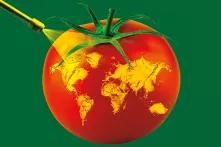
Insects provide pollination services to flowering plants, control pests and ensure abundant harvests. For a long time their populations have declined dramatically – causing disaster for humans and nature. Pesticides are considered a major reason for the decline.

Insect populations have declined sharply in recent decades. These downturns are of direct concern to humankind as we rely upon insects to deliver vital ‘ecosystem services’ such as pollination, recycling of nutrients and pest control. A review by the University of Sydney in 2018 compiled information from research studies in various regions. It found that the populations of 41 percent of species are in decline, and one-third of all insect species are threatened by extinction. While cautioning that the available evidence was relatively thin, the researchers estimated that total insect biomass is declining by 2.5 percent a year. Most of the research studies they included in their review came from Europe, some from North America and only a few from Asia, Africa or Latin America. Some examples: UK butterfly populations have fallen by about 50 percent since 1976, the biomass of flying insects in German nature reserves declined by 76 percent in the 27 years to 2016. In North America, populations of the Eastern monarch butterfly have fallen by 80 percent in 30 years, and in the Netherlands numbers of caddis flies fell by 60 percent between 2006 and 2016. There are many data gaps, particularly for tropical regions, but the evidence suggests that insect declines are a global phenomenon, and that they are ongoing.
There is broad agreement amongst scientists that insect declines are driven by a range of factors, including habitat destruction, climate crisis, light pollution, increasing fertilizer use, and the impacts of invasive species. Pesticides play a key role as well. Impacts of pesticides on insect populations have been examined in most detail for butterflies, a group of insects for which exists relatively good population data. For example, organic farms have been found to have more butterflies than non-organic neighbors, and pesticide-treated gardens had about half as many butterfly species as untreated ones. Use of neonicotinoid insecticides in particular have been found to correlate with patterns of butterfly decline, in both UK and California. However, it is not possible to accurately specify to which extent the decline is linked to the use of pesticides, not least because habitat loss, farming intensification and pesticide use are all strongly correlated with another.
The impacts of pesticides on the environment were first highlighted in 1962 by Rachel Carson in her book Silent Spring, which drew attention to the problems being caused by the extensive use of early insecticides such as DDT (dichlorodiphenyltrichloroethane) and organophosphates. Although these early chemicals were eventually banned in most countries, they have been replaced with successive generations of new compounds, many of them much more toxic to insects. For example the neonicotinoid insecticides, introduced in the 1990s and now the most popular insecticides in use globally, are approximately 7,000 times more toxic to insects than DDT.
According to their effect different pesticides have a different impact on insects: Even though insecticides should protect plants from pests they harm all insects, both the pests and beneficial insects. Since pesticide applications kill natural enemies of crop pests (insects such as ladybirds, hover flies and lacewings), populations of crop pests such as aphids often bounce back rapidly.
But also fungicides and herbicides are harmful to insects. For example some fungicides act synergistically with insecticides, rendering them more toxic if an insect is exposed to both at the same time. The herbicide glyphosate has recently been found to be harmful to bees, damaging their beneficial gut microbes and also affecting their learning abilities. Further, herbicides remove weeds such as wildflowers and foodplants which removes vital resources for insects for their larvae, thus indirectly impacting insect populations.
Systemic insecticides such as neonicotinoids contaminate soils and are taken up by the roots of wildflowers, so contaminating the nectar and pollen. Neonicotinoid insecticides have a range of sublethal impacts on bees, including impaired learning which interferes with communication and navigation; reduced immune function rendering them more susceptible to diseases; and reduced fecundity. A recent study found neonicotinoid insecticides in 75 percent of honey samples collected from around the world. Honey samples often contain not just neonicotinoids but a cocktail of ten or more pesticides, often including other insecticides, herbicides and fungicides. If honeybees are being exposed to these mixtures then it is very likely that thousands of other species of beneficial pollinating insects are also consuming them when they visit flowers. All these impacts are not taken into account enough in the regulatory process. Some negative impacts on pollinators are not even detected by regulatory studies. A progressive decline in insects threatens vital ecosystem services such as pollination, recycling, and biocontrol of pests, as well as removing a vital component of food webs, and ultimately endangers human wellbeing through the quality and quantity of our harvests.


